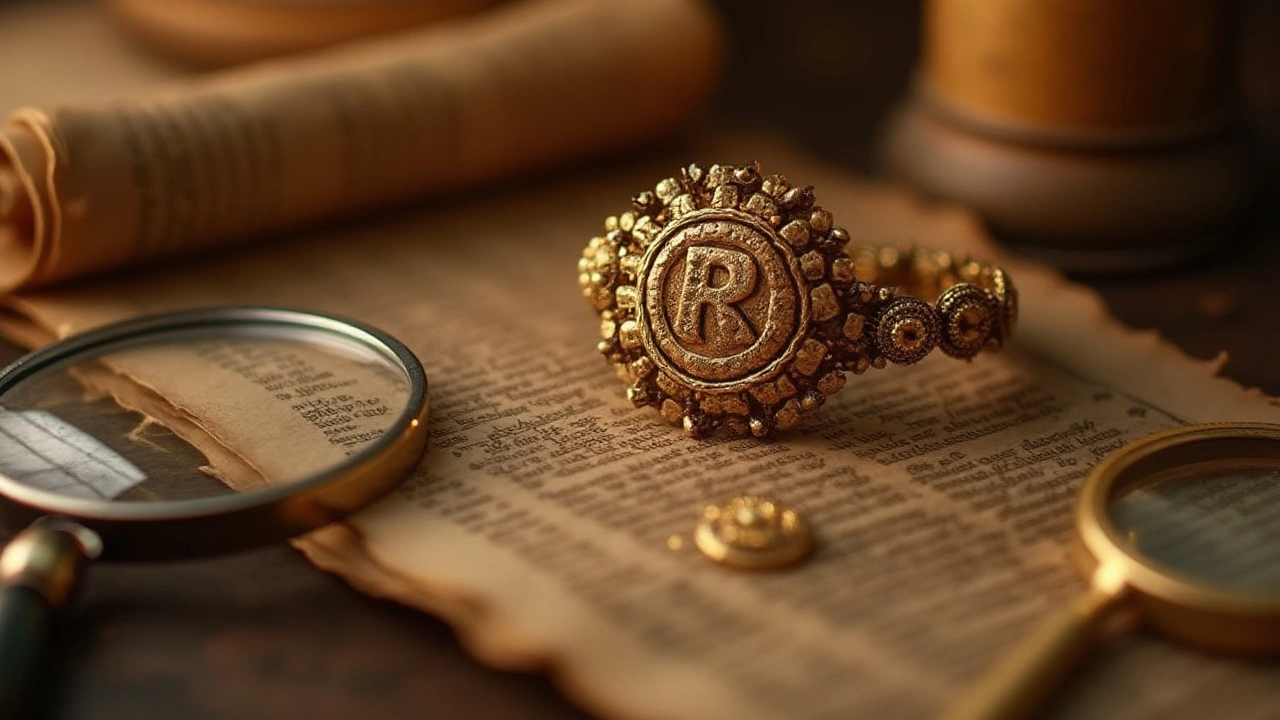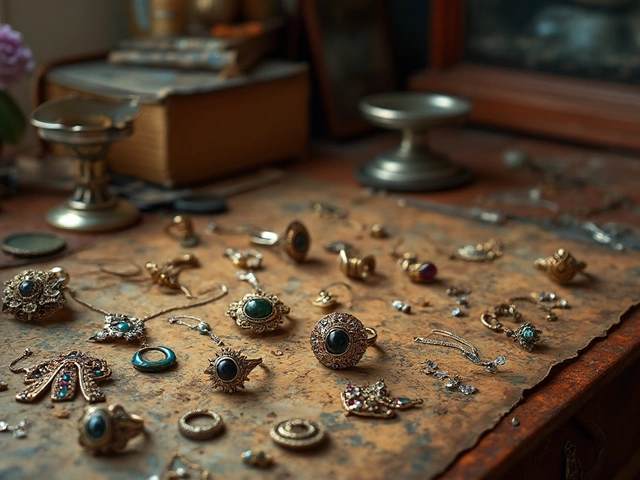
The world of antique jewelry is fascinating and filled with details that often hold the key to a piece's origins and history. Among these details, the markings on a piece can be particularly intriguing and mysterious. One such mark that often puzzles enthusiasts is the letter 'R'. What does this enigmatic letter signify when inscribed on a piece of jewelry?
In this exploration, we delve into the potential meanings and significance of the 'R' marking. From hints of a maker’s mark to an indicator of the type of metal, understanding these symbols can provide valuable insights. Whether you're a seasoned collector or simply curious about your latest find, deciphering these markings can enhance your appreciation of these timeless treasures.
- Understanding Jewelry Markings
- Historical Significance of 'R' Markings
- Tips for Authenticating Antique Jewelry
- Collecting and Valuing Jewelry with 'R' Marks
Understanding Jewelry Markings
Jewelry markings serve as invaluable tools for unraveling the secret lives of precious ornaments. These small, sometimes hidden, imprints offer significant clues about a piece's history, value, and origin. When it comes to antique jewelry, understanding these markings is crucial for anyone interested in collecting, appraising, or simply appreciating the beauty and craftsmanship of historical pieces. These engravings often include symbols, initials, or numbers, each with its own distinctive story to tell. The complexity lies in the varied meanings these symbols may possess, as they differ based on the era, location, and even the specific jeweler.
The purpose of these markings has evolved over time. Historically, they might have denoted the quality of the material used, such as the purity of gold or silver, or indicated the jeweler's identity who crafted the piece. In some instances, they serve as hallmarks, certifying that the jewelry meets certain legal standards or quality benchmarks. For instance, British jewelry often features marks to comply with strict hallmarking laws that date back to the 1300s, ensuring authenticity and purity of materials. In the United States, the karat mark is more common, revealing the gold content in the jewelry, ranging from 10K to 24K. Authenticity checks include verifying these markings with registry databases, which collectors frequently use to determine a piece’s legitimacy when partaking in the antique jewelry market.
One of the most intriguing aspects of jewelry markings is their role in uncovering a piece's provenance. They may reveal intriguing ties to a historical figure or a notable event, embedding the jewelry in a different time and place. Through detailed inspection and knowledge, one might learn that a seemingly insignificant ring was indeed a part of aristocratic attire or signified an era’s fashion trends. These stories enrich the item's history and can dramatically alter its perceived and actual value. "The hallmark of a great piece is the story it tells,” as noted in the esteemed 'Journal of Gemmology', captures the essence of why these markings are so adored and studied by experts and novices alike. Understanding these can transform one from a mere observer into a storyteller, a historian unraveling layers of meaning with each careful examination.
A practical approach to interpreting jewelry markings often involves familiarizing oneself with certain conventions used historically. Recognize that the significance of a letter such as 'R' may fall into numerous categories. It might signify the signature of a famed jeweler or indicate the city where it was crafted. Sometimes it serves as a date mark, acting as a temporal signature on the canvas of gold, silver, or platinum. In more recent years, the range of meanings has broadened, occasionally referring to trademarks or designer brands that have entered the antique scene, adding another layer to ponder during the inspection process.
For those sincerely drawn toward antique jewelry, investing time into learning about these markings is akin to learning a new language—one that speaks of beauty, heritage, and artistry. With every marking understood, a more vivid picture of the past emerges, allowing one to connect with the rich tapestry of history in a way that is personal and enduring. As such, collectors and enthusiasts are encouraged to dive deep into the nuances of jewelry markings. The insights gained not only enrich personal collections but also elevate one's role from a simple acquirer to a keen preserver of history. As you explore these markings, you will find that every piece has its own unique story, waiting beneath the surface, ready to captivate and enlighten those who choose to look closer.

Historical Significance of 'R' Markings
Antique jewelry enthusiasts often find themselves enraptured by the stories locked within each piece. Among the myriad of symbols and letters etched into these treasures, the letter 'R' stands out due to its multiple interpretations and historical significance. Throughout different eras, jewelry artisans used distinctive markings to leave their personal or brand imprint, a practice that was both a signature of craftsmanship and a method of quality control. The 'R' marking, therefore, can be a fascinating window into the past, offering insights not only into the piece’s origin but also into the societal nuances of the time.
The 'R' marking has taken on various meanings over the years. In some instances, it has been attributed to specific jewelers or manufacturers, serving as a hallmark indicating the creator’s identity or the firm. This was particularly prevalent in the period when hallmarking became formalized through guilds and legal frameworks aimed at protecting the authenticity of precious metals. The National Gold and Silver Stamping Act in the United States, passed in the early 20th century, is a key milestone in this regulatory history, introducing consistent standards that included maker’s marks. Often, 'R' could also denote an alloy used, with 'R' standing for Rhodium-plated or references to the region of manufacture, such as pieces originating from regions with renowned artisanal traditions.
One interesting anecdote relates to Russian heritage jewelry, where 'R' might be part of a larger, cyrillic inscription indicating both origin and period. Sometimes linked to the Romanov influence, jewels from imperial times often bore inscriptions that at a glance could seem mysterious but herald rich tales of opulence and history. The fascination here lies not only in decoding the meaning but in reimagining the world where these jewels once glittered in the candlelit courts of aristocracy. This perspective offers a narrative that transforms a piece of jewelry into a storytelling device, with each mark potentially unraveling historical events, cultural shifts, and artistic movements.
"Jewelry, like each thread of history it embodies, whispers its own unique story," remarked historian Dr. Anne Meadows during a 2015 lecture at the British Museum. "The 'R' might simply appear as a letter, but it often signals a doorway into a vastly interconnected past, where the glimmer of gold juxtaposes the harsh edges of time."
Collectors should consider the possibility that the 'R' mark could have been a hallmark of repute during certain periods, an emblem of trust and authenticity recognized both in local and international markets. Some research even suggests that certain jewelers adopted the 'R' mark to denote pieces that had undergone a specific refinement process, improving durability and sheen. These insights emphasize why understanding markings is crucial—it not only validates the piece but potentially elevates its historical and monetary value. The journey to uncovering these hidden truths is a rewarding aspect of collecting antique jewelry, bridging the gap between yesterday’s artisans and today’s connoisseurs.

Tips for Authenticating Antique Jewelry
When diving into the world of antique jewelry, ensuring the authenticity of a piece is crucial. It not only determines the item's value but also its historical significance. Authenticating antique jewelry involves a mix of art and science, requiring a keen eye and a bit of detective work. Identifying genuine pieces starts with understanding the craftsmanship characteristic of different eras. Look for the subtle details in the design, as true artisans often leave their unique marks in their creations. Examining the quality of work is vital since genuine vintage pieces commonly exhibit meticulous craftsmanship. It's also important to note that authentic vintage jewelry often shows signs of wear, which can indicate age but also requires careful consideration not to confuse it with damage.
Another essential step in authentication is to verify the jewelry markings. Marks like 'R', possibly indicating the registrar or sometimes the designer, can be pivotal. They serve as a signature, adding an element of mystery to the piece. These marks must be checked against historical records. The significance of these markings is enhanced once cross-referenced with historical databases to confirm their authenticity. The weight of the piece can also speak volumes. Precious metals were used more liberally in older pieces, providing them with a heft that's often lacking in modern reproductions.
As renowned jeweler Peter Jones once said, "The weight in your hand often tells the truth more honestly than the shine."
Materials used in old pieces also give clues about their origins. Use technology sparingly, but effectively. Instruments like loupes help inspect the work up close, revealing whether it was handmade—a strong indicator of authenticity. Testing the metal's quality, perhaps by checking its purity, can ascertain its age. Silversmiths' work, for instance, might have distinct patinas or tarnishing patterns that age does not affect uniformly. The age of gemstones can be tricky, so knowing the era-specific cuts can make a difference. Certain cuts popularized in past centuries, like the Old Mine or Rose cut, are rare today but indicative of authenticity.
Documentation can bolster the piece's credibility significantly. Provenance—a record of the piece's history—can elevate its value and provide an accurate timeline. Collaborate with reputable antique jewelry shops who might assist in assembling a more comprehensive history. When buying, always ask for documentation of prior ownership. Remember too, that a convincing-looking counterfeit may come with trumped-up provenance, so cross-verifying information is crucial. Engaging with historians or specialists can illuminate subtleties about the piece that casual appraisal misses. They bring invaluable insight, often understanding nuances that even seasoned collectors overlook.
Lastly, engage with trusted experts. Seek appraisals from certified professionals who specialize in jewelry identification. Their trained eyes can spot anomalies that average collectors overlook. They help build a comprehensive profile of the piece, factoring in everything from the cut of gemstones to the alloy blend in the metal. Participating in forums and community groups devoted to antique jewelry can be particularly beneficial as well. Sharing insights and experiences with fellow enthusiasts adds layers to your understanding while offering a supportive environment to validate your findings. Ultimately, patience and thoroughness are key when authenticating antique jewelry.

Collecting and Valuing Jewelry with 'R' Marks
Antique jewelry is a captivating realm where every piece tells a story through its design, craftsmanship, and the symbols engraved upon it. Among these symbols, the 'R' mark has piqued the curiosity of many collectors. It usually signifies various meanings that can shade light on the authenticity and history of a piece. Collecting jewelry with this specific mark requires a keen eye and a depth of knowledge in order to assess its true value. The 'R' mark might indicate the jeweler's or maker's identity, which can often add significant value to the piece given its historical connection. Experienced collectors often engage in detailed research or consult experts, ensuring that the 'R' mark aligns with the known hallmark timeline for specific regions and periods.
When valuing antique pieces, persistence in research is paramount. The rarity of the 'R' mark, the quality of the jewelry, and its historical context are pivotal factors that contribute to a piece’s worth. Detailed inspection involves not only identifying the markings but also understanding the design aspects typical to the era, which aids in establishing authenticity. Pieces from certain eras, such as the Edwardian or Art Nouveau periods, exhibit distinct styles often associated with quality craftsmanship, and the deduction of these can greatly increase a collector's confidence and thus the potential value of the piece. In certain cases, even the condition of the item plays a critical role; for instance, a well-preserved piece with minimal restorations often fetches higher values compared to one fraught with damages.
“According to John Smith, an expert jewelry historian, 'The intrigue of antique jewelry lies largely in its mystery and the journey of unraveling each piece’s past. The 'R' mark, for those who decipher its meaning, is a gateway to history.'”
The Role of Provenance
Provenance adds an additional layer of value to any collectible piece, allowing potential buyers to trace its lineage. For collectors focusing on items with the 'R' mark, understanding the previous ownership and the transitions through which the jewelry has traveled enriches its story. This history can prove invaluable when validating the claims made by sellers and can often be the decisive factor in the purchase. It is not uncommon for auction houses to provide detailed provenance reports which instill confidence and often lead to record sales. Jewelry with a confirmed and documented connection to historical figures or prestigious sources is particularly coveted and sought after.A structured approach to collecting such antique jewelry adds to the success rate in acquiring valuable pieces. Potential collectors should establish a network with other jewelry enthusiasts and experts, participating in forums and attending specialty auctions. Keeping abreast of market trends and recent sales can also inform strategic decisions. This community-focused approach fosters robust discussion and sharing of insights, contributing to a deeper understanding of the ever-evolving collectible jewelry landscape.


